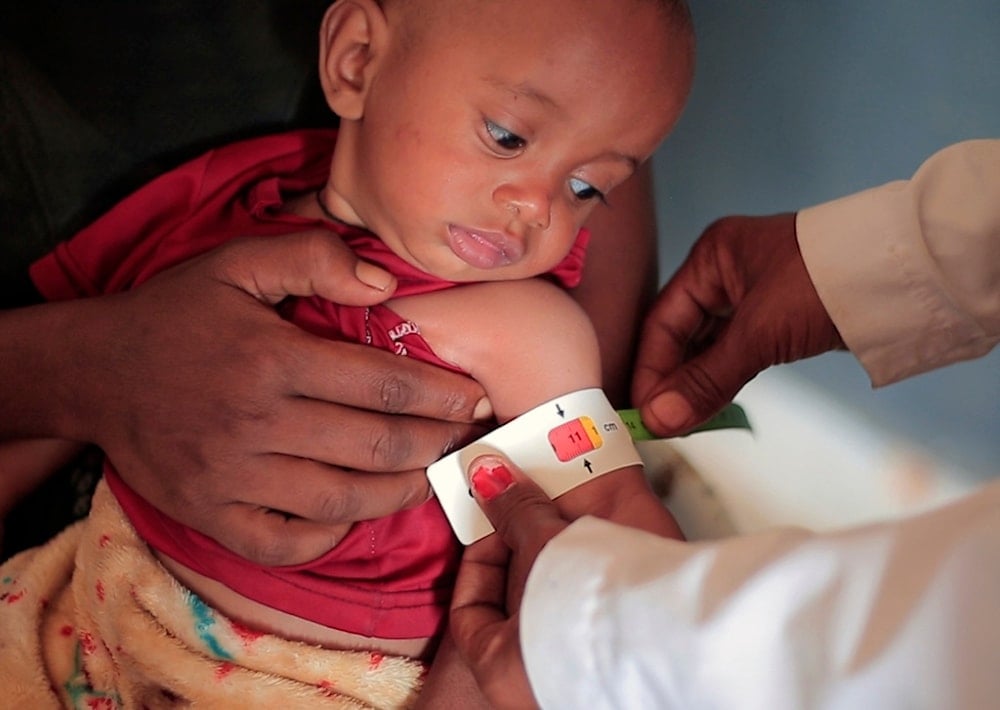WFP warns global aid cuts threaten 13.7 million with hunger
The World Food Programme warns that drastic US aid cuts and a global funding collapse could push nearly 14 million people in six countries to the brink of famine.
-

In this image made from video, a nurse measures the arm circumference of Temesgen Muluhaw, 8 months old, who is suffering from malnutrition, at the Finarwa Health Center in Mai Mekden, in the Tigray region of northern Ethiopia, on Tuesday, Feb. 27, 2024. (AP)
The United Nations World Food Programme (WFP) warned on Wednesday that nearly 14 million people across six crisis-affected countries could face extreme hunger as international humanitarian funding dries up.
Populations in Afghanistan, the Democratic Republic of Congo, Haiti, Somalia, South Sudan, and Sudan are among the most at risk, as the WFP grapples with an unprecedented financial shortfall caused by major reductions in aid from key donor nations.
Aid retrenchment
The United States, traditionally the WFP's largest contributor, has drastically reduced its foreign assistance under President Donald Trump. Washington's contribution to the agency reportedly fell from nearly $4.5 billion last year to about $1.5 billion in 2025. The cuts were largely implemented through the dismantling of USAID's global operations and the termination of most of its humanitarian programs, which have been either absorbed by the State Department or eliminated altogether.
Other governments have also delayed or reduced funding, intensifying the strain on relief efforts. The WFP said it expects to receive 40 percent less funding in 2025, with its projected budget dropping to $6.4 billion from $10 billion in 2024.
Hunger crisis deepens
In its latest report, A Lifeline at Risk, the agency warned that 13.7 million people could move from "crisis" to "emergency" levels of hunger, one step below famine on the global five-tier scale.
"The gap between what WFP needs to do and what we can afford to do has never been larger. We are at risk of losing decades of progress in the fight against hunger," said WFP Executive Director Cindy McCain.
She cautioned that even regions showing improvement, such as the Sahel, where half a million people have recently reduced their dependence on aid, could slide backward. "It's not just the countries engulfed in major emergencies. Even hard-won gains in the Sahel region, where 500,000 people have been lifted out of aid dependence, could experience severe setbacks without help, and we want to prevent that," she added.
Humanitarian strain
In response to shrinking budgets, the WFP has begun cutting food rations and narrowing its list of beneficiaries to focus on those facing the most severe hunger. The United Nations has also tapped emergency pooled funds, such as the Central Emergency Response Fund, to maintain critical operations, though officials admit these stopgap measures cannot compensate for the scale of the losses.
Other UN agencies, including UNICEF, are bracing for budget shortfalls of up to 20 percent in the coming year, forcing program cuts and staff reductions. The broader humanitarian system faces what officials describe as a structural crisis, driven by donor fatigue, economic uncertainty, and the diversion of resources to other global emergencies.
Funding vacuum
Analysts note that while China's international aid profile has expanded in recent years, its support remains focused on infrastructure and bilateral development projects rather than flexible, grant-based humanitarian assistance. As a result, it has not filled the funding vacuum left by the US withdrawal.
The WFP's warning comes amid a worsening global hunger crisis, one not caused by food scarcity but by political and financial retreat, leaving millions of the world's most vulnerable people on the edge of starvation.
Read more: WFP shuts down southern Africa bureau amid funding cuts, drought

 3 Min Read
3 Min Read








